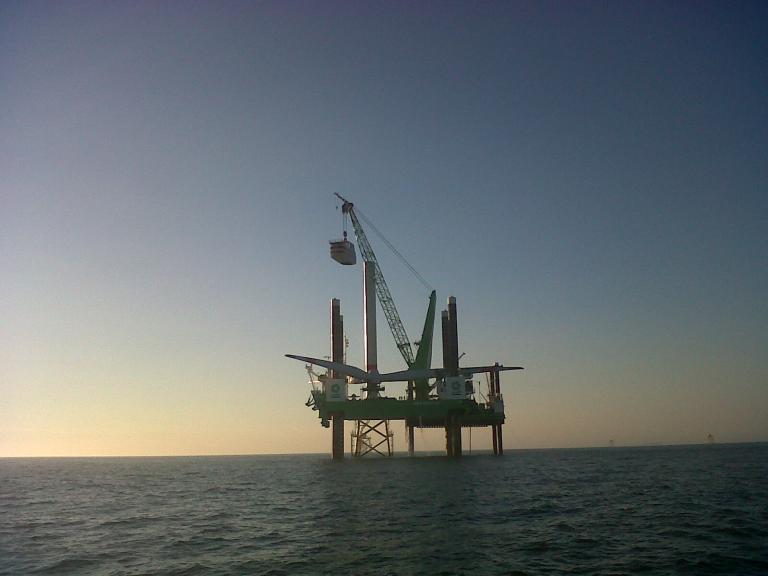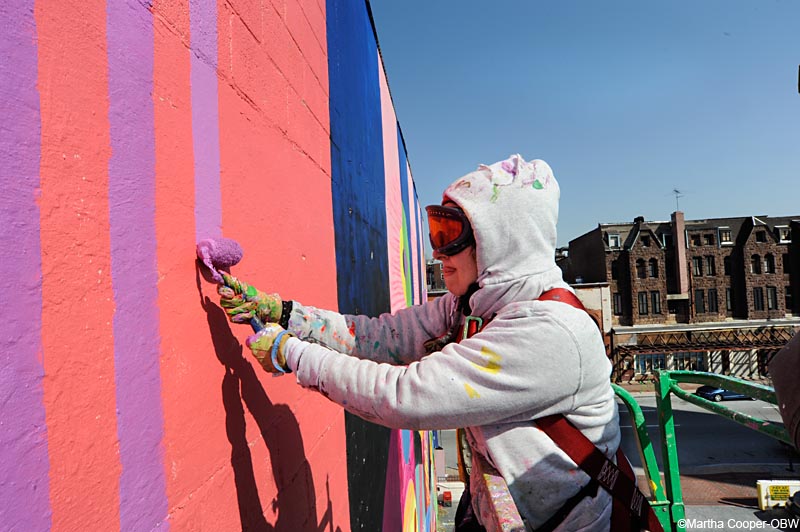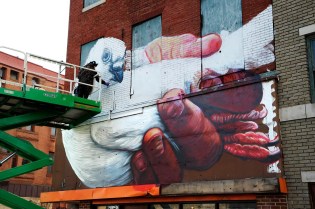
The artist Gaia puts up the first installation in what he calls "a museum for street art." (Photo by Martha Cooper.)
Street artists from around the world are descending on Baltimore this spring to take part in an ambitious — and totally legal — exhibition, producing murals for an event designed to bring new life to a transitional neighborhood.
Launched this month and running through the end of May, Open Walls Baltimore is the city’s first officially sanctioned street art exhibition. Twenty walls throughout the Station North Arts and Entertainment District will serve as backdrops for murals that will be created over the course of several weeks. The walls to be painted are a mix of both private homes and commercial buildings, and represent both occupied and vacant structures. “It’s a museum for street art,” says the artist Gaia, who is curating the event.
Gaia put up the first mural earlier this month — an oversized carrier pigeon adorning an empty building at a major intersection in Station North. With its ample warehouse space, cheap rent, and proximity to the city’s train station, the district has long been a haven for students from the nearby Maryland Institute College of Art (MICA) as well as for professional visual and performing artists, musicians, filmmakers, and other creative entrepreneurs. Before Duff Goldman became the Ace of Cakes, he performed guerilla cooking shows in a warehouse here; musician Dan Deacon and his Wham City Arts got their start in the district’s Copycat Building.
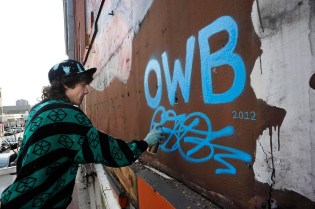
Gaia curated the Open Walls Baltimore show in the Station North Arts and Entertainment District. (Photo by Martha Cooper.)
But this is also a place that never fully recovered from the 1968 race riots and decades of urban disinvestment. The community suffers from high vacancy, empty lots, low incomes, and crime. “Many people look at [Open Walls] as an art activity, but from our point of view at the bank, this is a neighborhood revitalization play,” says Will Backstrom, community development banking manager for PNC, who helped develop and fund Open Walls through the PNC Foundation. The project also received funding through a grant from the National Endowment of the Arts, and was organized by Station North Arts & Entertainment, LLC.
Backstrom had seen Gaia’s work around Baltimore and then he saw the 2010 documentary Exit Through the Gift Shop about the rising street art phenomenon. Around the same time he read a story in a Maryland business journal about how street art in Miami was spurring new business. Backstrom says he does not have hard data on the return on investment for a city embracing a street art project like Open Walls, but anecdotally there are reports of it being an economic driver. “In Miami, a new moped company started just so people could tour the city’s street art,” he says.
It’s hard to pinpoint when, exactly, street art tipped from illegal enterprise to mainstream arts activity, but it’s safe to say that it was in the groundwater by May 2007 when the anonymous street artist Banksy earned a profile in The New Yorker and people like Brad Pitt started collecting street art. Cities like Philadelphia, Atlanta, Los Angeles, London, Barcelona, and others have appropriated what was once an illegal art form for economic revitalization purposes.
“You go to the Wynwood [neighborhood in Miami] because you want to see a Shepard Fairey,” Gaia says. “You want to see artwork that has established some fame and recognition and has become a gem. The art there is raising property values.”
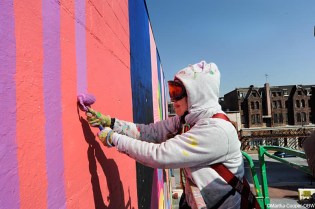
Street artist Maya Hayuk, working her magic in the clear light of day. (Photo by Martha Cooper.)
Open Walls is not seen as a panacea for a struggling neighborhood, rather it’s happening in concert with a number of other endeavors. In Station North there is new affordable live/work space for artists, and a new Baltimore Montessori Public Charter School. An abandoned clothing factory will soon be home to a design school for public middle and high school students, and nearby MICA, a private arts college, is investing heavily in the area. Slowly but surely, businesses are returning, coffee shops are opening, theaters and galleries are welcoming patrons.
Open Walls aims to capitalize on the international reputation of participating street artists, including New York’s Swoon and Portugal’s Vhils, to draw new people into the district. “There are a lot of good thing happening in Station North, but they are not known to a broader audience,” Backstrom says. “This is a way to put gas on the fire of what is happening already and to get potential investors into the neighborhood. Our goal is to get people to buy vacant houses and buildings.”
The use of street art as an economic development tool is an ironic turn, considering that many artists have used their work to draw attention to injustice or imbalance in the ecosystem of the city. Much of Gaia’s street art in Baltimore offers a critique of a capitalistic society built on private property and the disinvestment in the American city. With Open Walls, he and his contemporaries are embracing official events that could, if successful, raise property values and price out existing residents.
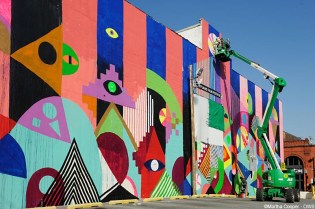
Maya Hayuk's wall. (Photo by Martha Cooper.)
Gaia recognizes this. “If this results in the neighborhood flipping, it will be a tremendous failure and I will feel really guilty,” he says. “But I don’t think it will. We’ve gotten good at trying to save neighborhoods while also being sensitive to the existing population.”
In Station North this includes working with the local neighborhood associations and the city on things such as tax breaks for working artists, affordable housing developments, and programs like the mayor’s new Vacants to Value initiative that makes it easier for potential homebuyers to purchase city-owned vacant property.
“We’re so burdened in America by the real estate holdings of people, we’re so burdened by this presence of difficult properties sitting inert and then suddenly all of the invisible forces come together and they can literally transform it overnight,” Gaia says. “This neighborhood has sat idly with more than 150 abandoned properties. It is primed and ready for change.”
